Header image: The wedding of Margaret Alice Lomas (Madge) and Herbert E Greenfield, England or Wales, circa 1910-3.
Front row, left to right: Uncle Herbert Lomas with Nesta on his knee; Herbert Greenfield’s mother; Marion Lomas (mother to Dorothy and Lloyd); Uncle Herbert Greenwood; Auntie Madge; Alfred Edward Jenkins with the top hat on his knee (father to Dorothy and Lloyd); Phoebe Lomas (nee Smith, Marion and Madge’s mother, sister to the Smith sisters Sarah, Polly and Florrie).
From the collection of Dorothy Simkin.
We all generate stuff in our lifetimes. So much of it is binned on our deaths. But I’ve been thinking lately about where the Smith sisters’ stuff might have ended up. If it had somehow survived to 2022, where would it be? Who has it?
Not the crockery or the jewels. The treasures I’m looking out for are letters, diaries, and photographs. Documents that could provide another breadcrumb and potentially open a new door. They might have a slightly higher chance of survival, if the right person picked them up.
Florence was the last Smith sister to die in New Zealand in Wellington, in 1942. At the time, she had two living relatives here that were both included in her will: my great-grandmother Marion (based in the South Island), and my great grand-aunt Helen (Marion’s brother’s widow, also known as Nellie, or Sarah Ellen Fort, who lived in the Hutt Valley).
Great grand-aunt Helen
For a lot of reasons, I counted Helen out. She lived in the same region, so I believe she’s the most likely to have inherited any stuff the Smith sisters had, but tracking it down would be next to impossible. The bloodline ended in 1982, and by that time the family had drifted apart.
Helen’s surviving daughter Nancie left her doll collection to half a dozen members of her husband’s family, and no-one from her own. Whatever treasures went to Helen are dust in the wind in 2022, 40 years after the death of her child-free daughter.
There will probably be a blog in the future on this branch of the family once I’ve verified some things, but having discovered my most-likely candidate was – at least for now – a dead-end, I moved on to my great grandmother Marion.
Chasing the chain of possession
I thought it was possible my great-grandmother Marion maybe picked up a few things. And I thought anything that Marion had, probably went to her daughter Dorothy – my grandfather Lloyd’s sister.
And that’s where things got hard for me. We don’t know any of Dad’s cousins. Finding the living members of our family was going to require some mighty Google-Fu, and by golly even I was impressed with how I did.
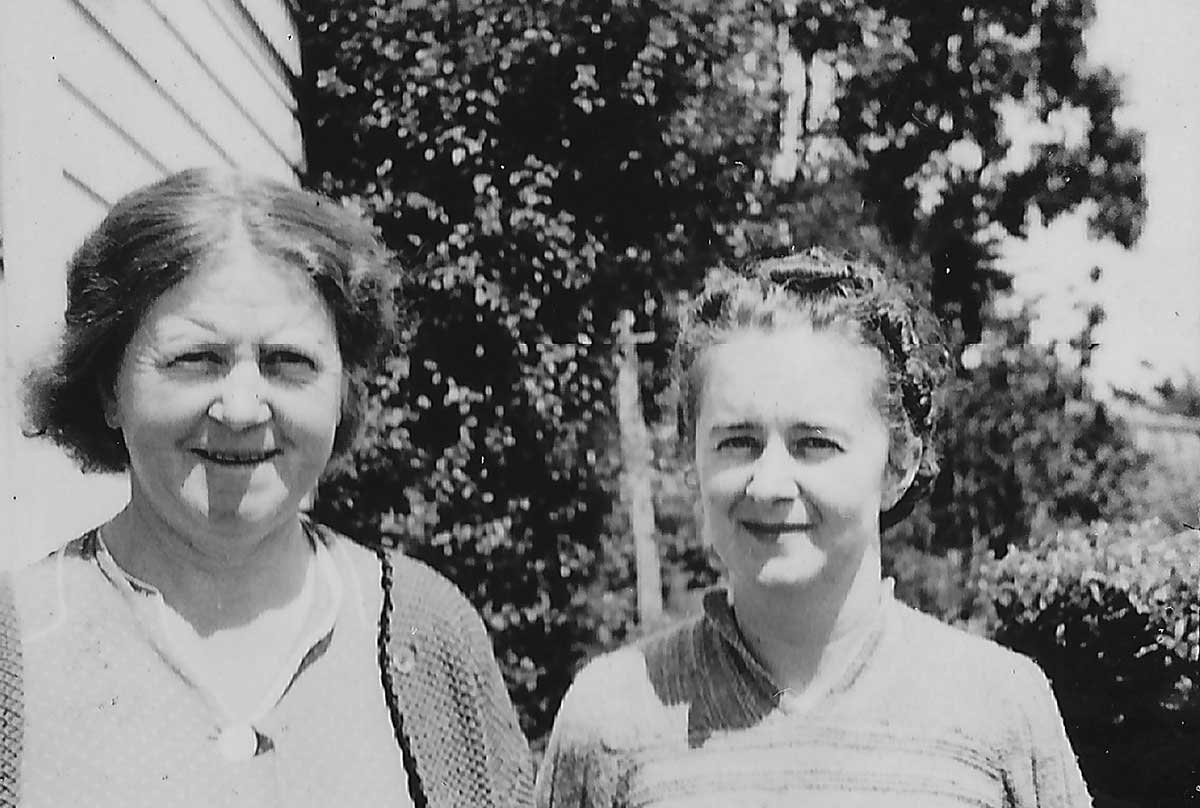
Marion Jenkins and her daughter Dorothy. From the collection of Lloyd Jenkins.
Forgive me for being a bit vague about the living family members, but if my assumption that Dorothy had inherited the ‘family stuff’ was correct, then there was one person would have it in 2022: her son.
I only knew his first and last name, and the year he got married, but that was enough to start. I found him in Electoral Rolls from the late 70’s and early 80’s next to his wife. Googling her led me to the website for their daughter’s upcoming wedding in Canada – and an email address.
My new second cousin
I sent the bride-to-be an email – I included the photo I had of her parent’s wedding and explained what I thought our relationship was. I asked if she could put me in touch with her father.
She replied pretty quickly and confirmed I did have the right person, and she’d talk to her dad.
I wasn’t sure at this point if Dorothy actually did collect family ‘stuff’, or if it had managed to survive the 15 years since her passing. But I couldn’t come this far and not ask either. I knew she had some knowledge of the family tree, but I didn’t know how serious it was.
I was given an email address. I sent another email, and I waited.
Later that afternoon they got in touch. Dorothy did have a collection, and it had survived. And it was only a few hours down the road – within the Northland region!
Not only that, but coincidentally, they had already planned a trip to Kerikeri the next day. Would I like to pick the collection up and take it for a little while?
The invisible team
I was floored. More than once since I’ve begun looking into my family history, the right thought has struck at the right moment and the right lead has paid off spectacularly. Sometimes I have very strong hunches or go on seemingly random tangents that end up making complete sense a couple of weeks later.
In fact, it happens so often, I find it hard to believe I’m doing this alone. It feels like there’s a team on the ‘Other Side’ playing this game alongside me. It always seems so silly when I write it, but it’s how it feels.
I mean, what are the chances that an email sent to a stranger in Canada would lead to a collection of ‘lost’ and absolutely priceless family documents being delivered to me in a far corner of New Zealand the next day?
Not even Amazon can do that! It usually takes a week or longer to pull a document from Internal Affairs or Archives. Dorothy’s stuff was practically instantaneous!
The treasure lands
Dorothy’s cache is… just marvelous. It contains photographs, letters, and birth and marriage certificates dating back to the early to mid-1800’s. Like me, she had her specific obsession. Where I can’t stop chasing the Smith sisters, Dorothy was chasing the origins of a silver bracelet.
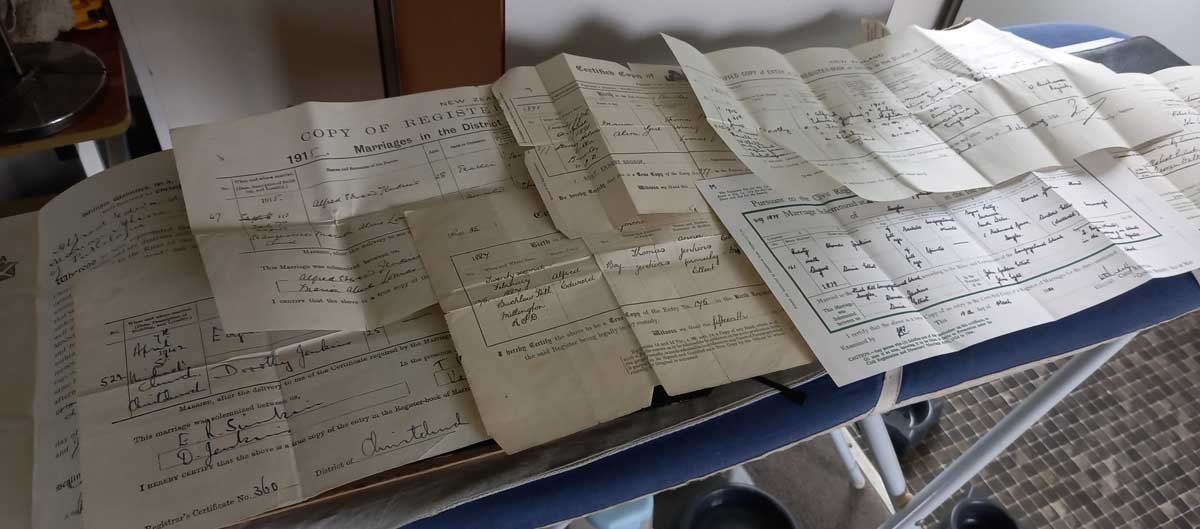
Family marriage and birth certificates. The oldest dates to 1844.
The photos go back generations. The letters go back to the 1970’s. There’s an evolution over time of Dorothy’s understanding of how the pieces fit together.
At this stage, I feel fairly confident saying Dorothy was our first ‘Family Historian’.
Her work was slow. When she wanted to access say an English Census record, Dorothy wrote to someone in the UK. Then that person then had to go physically find the record in whatever Archive it was stored. They would write down what they found, and mail it back to Dorothy in New Zealand.
It took her years to build the tree I was lucky enough to start from.
Comparatively, I can open that exact same Census record in around 6 clicks from my desk in rural New Zealand.
Everything is automatic. It will find the people I ask it to find, open the record to the right page, and attach it to the relevant people on my tree in just a few steps.
OK, but back to that cake shop
Like me, Dorothy was curious about her spinster grant-aunts.
It turns out, Dorothy was the author of the two sentences that began my entire search, and a few more sentences exist. She actually met them and had recollections spread throughout her notes.
“Grandfather Lomas (supposed to have married beneath him), married Phoebe Smith whose three sisters came out to New Zealand and they were my (great) Aunts, Polly, Florrie and (Sarah?) and they started up a cake shop in Wellington proper – they were considered excellent bakers (this was how mum was such a good pastry maker). We stayed with Poll and Florrie up on the hill in Wellington where they took in boarders.”
Excerpt from letter from Dorothy Simkin to Lloyd Jenkins 11 July 1994
“Grandmother Phoebe, mum’s mother visited N.Z. twice. I remember the visit in about 1919. I think her sisters Polly and Florrie must have come to New Zealand about the turn of the Century. They had a pastrycook and cake shop in Central Wellington (I think). Mum said they were fabulous bakers. When we visited them about 1924 they had a two-storied boarding house in Shortland Street (I think). They could see the wharves from their house on the hill.”
Excerpt from letter from Dorothy Simkin to Lloyd Jenkins 1980s
But it was in the letters I struck real gold.
“They were feeling what we call, fed up”
In 1972, Dorothy received a letter from Madge Greenfield, her aunt in the UK (Marion’s sister – the bride in the wedding photo at the top of the page).
There is half a page at the start where she talks about a nightie Dorothy sent her, but then she spills the tea.
“Now I must try and let you know about Auntie Polly and Auntie Florrie, there was also Auntie Sarah, all were mother’s sisters and spinsters. I was rather surprised your mother had not told you about them. The reason they went out in the first place, my mother was already out, there was also my brother Ernest and Nellie, Nancy’s Mum and Dad, then you Mum and Dad. Business was very bad in England at the time. Aunt Sarah had a small shop and Auntie Polly was with her as confectioners, and Aunt Florrie had a small shop selling knitting wools and fancy work. It was a, what they call slump in business, and they were feeling, what we call fed up. Aunt Sarah was a lovely cook, she did all the baking for the shop. They were the last to go out, intending to look for a fair-sized house and cater for boarders, which they did. They were out a few years when Aunt Sarah died. We all loved her very much. She was so very good to us when we were children. My mother was the eldest, then Aunt Sarah next. Aunt Florrie was the youngest. She and Aunt Polly kept taking boarders. My brother Ernest and Nellie were the first to go out the emigrated about 1911. My mother and your mother and dad went out in 1913, just after your uncle Herbert and I were married, then Sarah, Polly, and Florrie went out while the First World War was on about 1916.”
Letter from Madge Greenfield to Dorothy Simkin 23 September 1972
The full scan of the original letter can be viewed here (and here is the full plain-text transcription). Huge thanks to the people of New Zealand Twitter for helping me to transcribe the harder bits.
So – we already know for sure the ladies arrived in Wellington in September 1915 because I found the immigration record. Now we know what made them get on that boat.
Firstly, they had a decent number of family members here (my count is eight of them in 1915, with Dorothy on the way). Secondly, the First World War. This is pretty much what I thought it was about, but it’s nice to have it confirmed.
Madge confirms that Sarah and Polly are the confectioners. And brings us the news that Florrie ran her own little craft shop too.
So they were three fairly business-savvy ladies who could really cook when war broke out and caused them to re-prioritise. They hopped on a boat to see if New Zealand would be any better, because they knew some people here (and it was as far as you could get from that war).
Back to 146 The Terrace
Madge’s letter really does shed new light on the meaning of 146 The Terrace (last discussed in the second post). Dorothy’s notes call it Shortland Street, but we know it is 146 The Terrace from electoral and death records. The ladies weren’t simply staying there – they ran it! They had come to New Zealand with the specific intention to run a boarding house.
Interestingly, it was my understanding that single women couldn’t own property in New Zealand. In fact, they totally could!
Shayne Parkinson, (Women and the Law)
With laws like these, who needs a husband, huh?
This is an evolving situation I’m making slow progress on. It’s looking like another blog in and of itself, so I won’t waste more words on it here.
Aunt Sarah?
Amongst Dorothy’s cache was two very small, very faded, very blurry photos labelled ‘Aunt Sarah’.
I’ve tried scanning them at 1200 and 600 dpi, but I think if I’m going to get anything I’m happy about, I need to get the photos restored.
The photo at the top of the page is the wedding photo of the Smith sisters’ niece (and Dorothy’s Aunt), Madge. It was taken shortly before everyone got on boats and came to New Zealand. I know who is in the bottom row, but there’s nothing recorded about the people in the top row.
It might not be highly likely, but it’s not impossible to think the Smith sisters might be in this photo. Perhaps the older 3 ladies with the nice hats?
Having Sarah’s photo restored will confirm or not. I might as well get the wedding photo restored too. I can’t get a good scan of it with my equipment, and it’s such a great photo I definitely want to preserve it.
Finally, I promise
I’m sorry, I know this post is very long. Thank you for getting this far. There’s just one final thing I have to mention before I go.
You may recall that in her Will, Florence directed:
“…that at a convenient time after my interment such grave shall be restored and put in good order and condition.”
Well, over Easter Weekend the Friends of Karori Cemetery had a working bee and found some time that was convenient to spruce up the sisters’ grave.

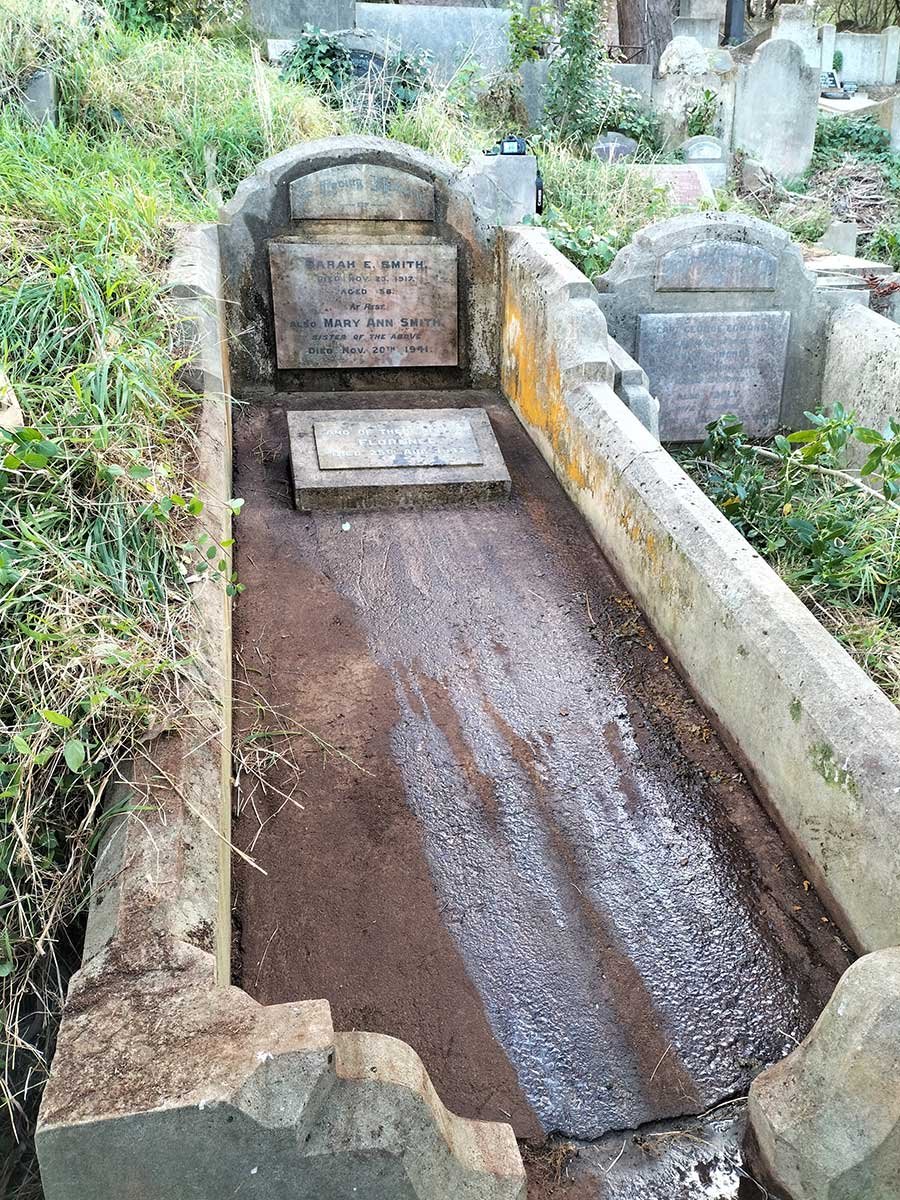
They did an incredible job, and it’s nice to see that the grave is still structurally sound. There’s a couple of videos of their work too:
A little working bee by some of the committee members today. @katjnz asked us to give some of her family members a tidy up. pic.twitter.com/6DiTNVSbOc
— Friends of Karori Cemetery (@KaroriCemetery) April 17, 2022
I am so grateful to them for fulfilling this final wish for the Smith sisters. Trying to find out anything about three single women in early 20th Century New Zealand is proving… not impossible, but quite tough.
The most solid and tangible connection we have to their lives is that grave. So there’s a nice feeling knowing that they’ve been given a spruce up, and they’re not simply lying forgotten anymore.
It proves they were here. They were real women who lived for up to 25 years in this country. We are slowly filling in the blanks of their lives, but there’s still so much more to find out.
More to the story
This post is just one part of the story. If you haven't read them all, they're all listed here.
Part One - The spinster Smiths
Part Two - The Death of Sarah Smith
Part Three - Finding the 'family stuff'
Part Four - The Smith sister's boarding houses
Part 4.5 - A week away (where I go to Wellington - some updates to this story)



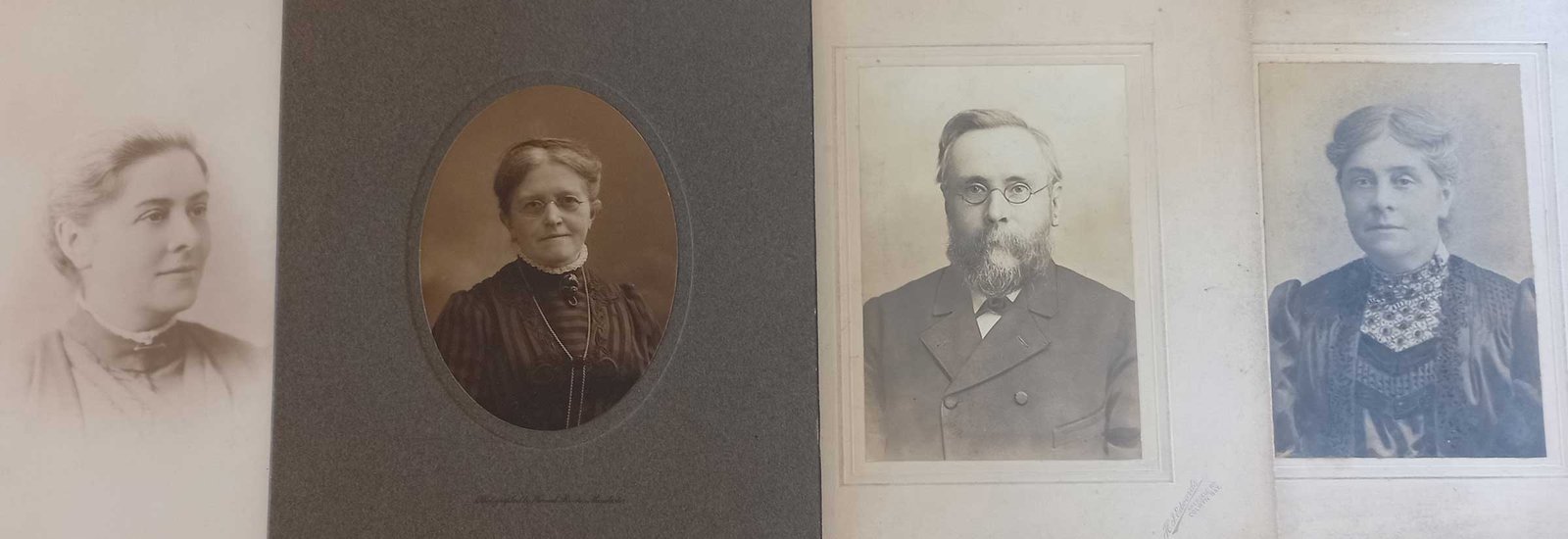

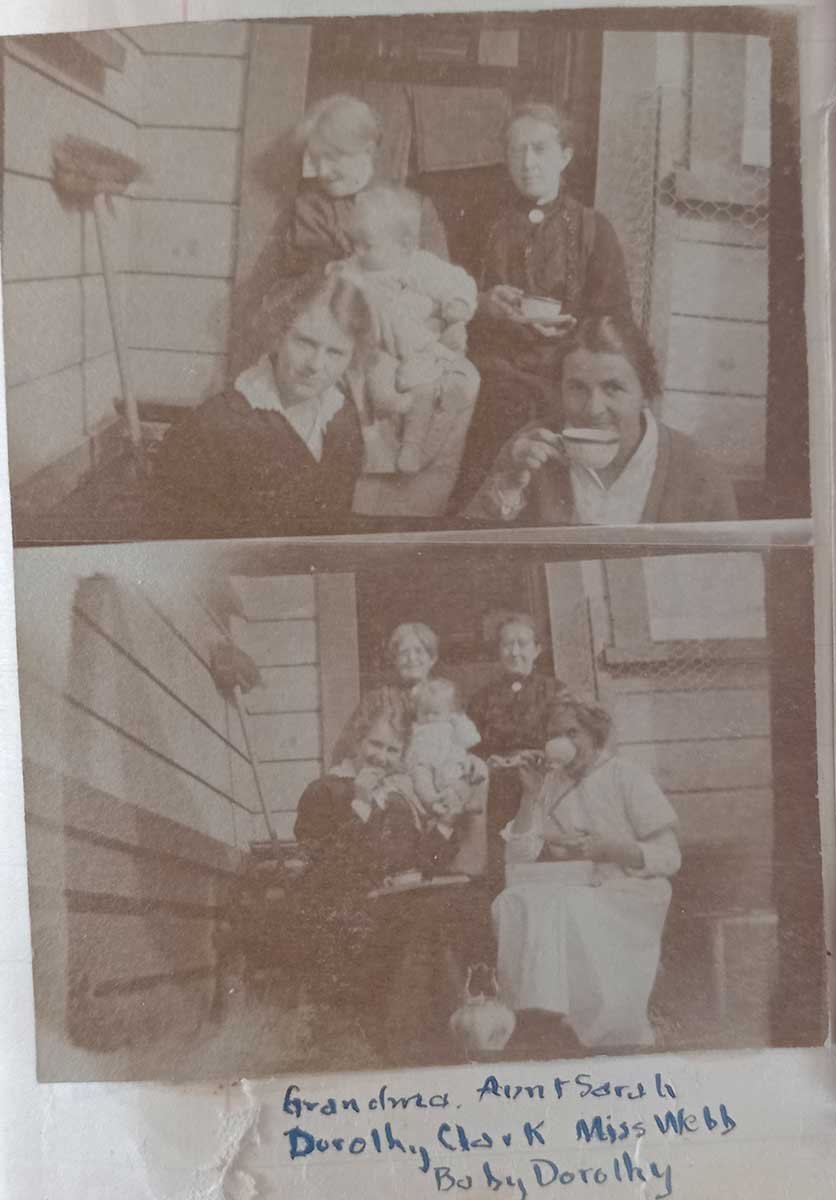

Hi Kat You are doing well with your family tree. Have you got a DVD player? I have found some videos which where taken at Pops 70th birthday and you where a ‘Star Dancer’. Also Mathews 21st birthday and Adams wedding. Your mum is in it. Let me know if you would like a copy on DVD. and I will put one together for your collection and post it to you. cheers Rob.